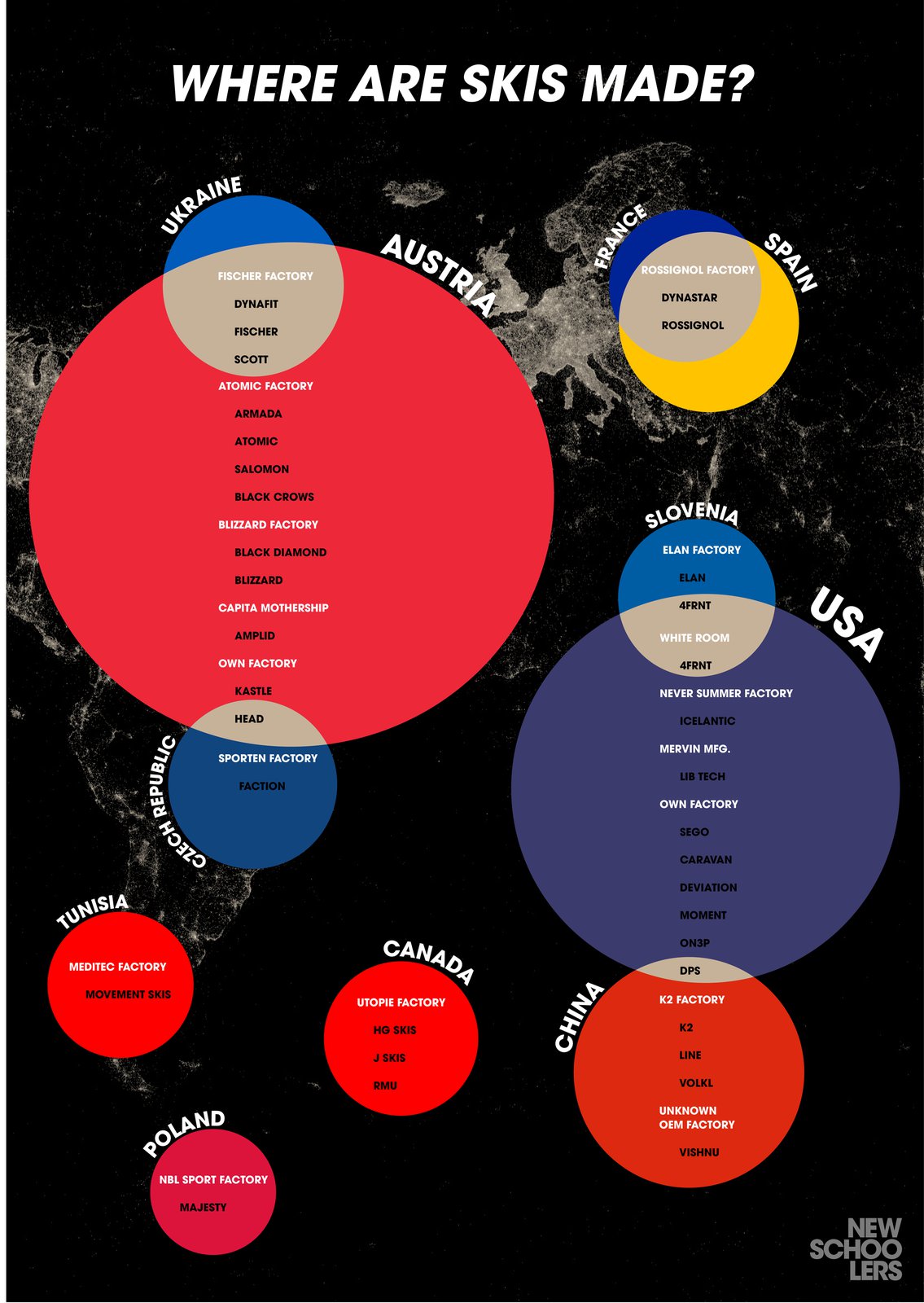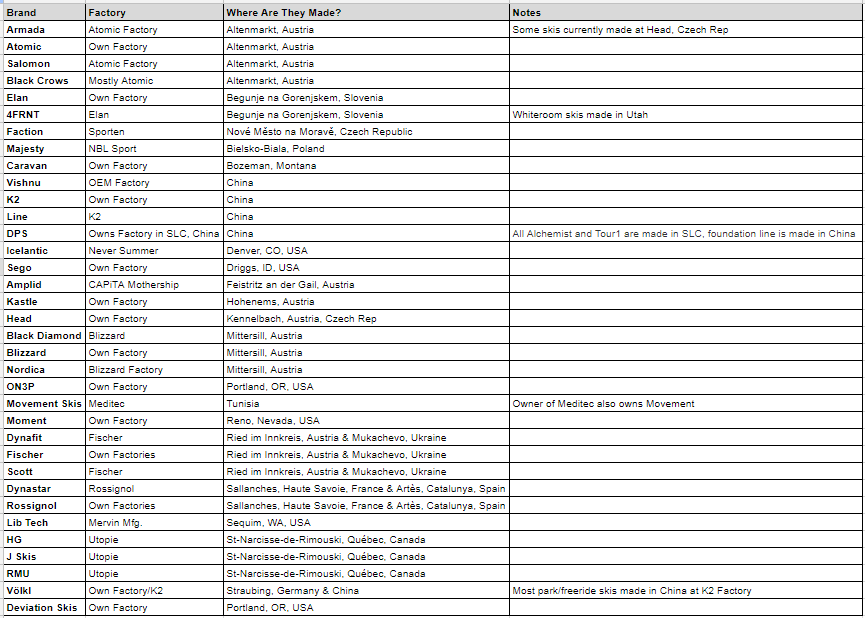With the language of international politics turning more hostile to globalization, knowledge of where a product is made has become increasingly important to (some) shoppers. In skiing, consumers are rarely given an insight into production aside from a handful of small brands who base much of their marketing on producing locally. We spent the last couple of months researching the topic in an effort to bring some clarity and inform the consumer of who builds what skis, where.
Most companies do not publish where their skis are made but simply put, the majority of companies do not build their own skis. Instead they outsource, leaving the duty of production to other brands (often owned by the same holding company) with their own factories or to OEM factories in any number of locations across the globe. Through digging around online, and with help from my friends at evo, this is the most accurate guide to manufacture we could come up with. Since brands without their own factories frequently change manufacturer, the best way to know for sure is to look for the “Made In…” on the skis themselves.

Brands can also make different skis in several different factories. For example, this year's Armada ARV 96, 86, and B-Dogs are all made in the Czech Republic, while the Edollo, ARV 106 and many others are made in the Atomic factory in Austria. Adding yet another layer of complication, brands often change factory from year to year. RMU are currently made at Utopie, but are reportedly moving to the Blizzard Factory for next season. More of Armada’s production will almost surely shift to Atomic’s factory after Armada’s acquisition by Atomic’s parent company, Amer.
There are a handful of factories on this list, for example Utopie and NBL Sport, that are not attached to a familiar ski company name. These are original equipment manufacturers, or OEMs. These factories focus solely on the production of goods, rather than the marketing, selling, and fulfilment that comes with them. In other words, they make the skis that other brands sell.
One reason that information on manufacture is rarely publicized by brands is that there are stigmas attached to labels such as ‘made in china’, producing in an OEM or even having your skis produced by someone else. The prejudice against OEMs stems from the fact that using one distances the brand from processes like prototyping and quality control. There is no doubt that not having your own production complicates the prototyping process, especially if you are removed from the factory in question by many thousands of miles and a language barrier.
However, while there is certainly a stigma surrounding OEM factories, it is important to acknowledge that there are both positive and negative aspects to producing in this way. Using an OEM can be positive, allowing smaller brands to scale and giving them access to production experience that would take years to gain if you started a factory of your own.
Some brands embrace their OEM factories, while others remain secretive and defensive. When asked about where their skis are produced, a co-founder of Vishnu Skis jumped immediately to the defensive responding with this, “Where [the skis] come from is, for the most part, irrelevant. By making a list like this you are realistically damaging the reputation of companies that don’t fit the “MADE IN USA” narrative you are going for.“ This in response to simply being asked “What factory are your skis made in? Where is that located?”
https://www.newschoolers.com/videos/watch/883074/J-Ski-Factory-TourJ Lev gives a tour of "his" factory, Utopie
Jason Levinthal, whose skis for J Skis are made in the Quebec based OEM factory Utopie is, by contrast, completely open about how his skis get made. When we discussed the topic with him, he posed the following: “Apple doesn’t build any of their own products… are they not a real computer company?” He went on to stress the difficult financial realities of a capital intensive seasonal business, saying “The reality is that if the first day you go into business, you build a ski factory, buy the machines, hire all the employees needed, the 2nd day you’ll be bankrupt. If you borrow money or get an investor to make it happen, you’ll simply delay bankruptcy”. While this is somewhat of an exaggeration, it’s undoubtedly true that it’s very difficult to fund a ski company, let alone a ski factory.
https://www.instagram.com/p/BeCKmn6lduL/?taken-by=on3pskico
It’s important to note that while it is helpful to know the origin of skis, where a ski is produced does not necessarily equate to its quality or durability. There are plenty of great skis made in China and in OEM factories, and there are definitely shitty skis made in the USA. Anyone can go on Alibaba and start a ski company, you can even find the factory that Revision used, but not everyone has the ability to create and test prototypes and be there every step of the process to communicate design, construction and quality control.
Factories operate on very thin profit margins, and are subject to fluctuating prices of materials, labor laws, and other factors that can cause a factory to dark overnight. Without close contact with the factory, and boots on the factory floor it is easy to end up high-and-dry, as has been seen several times over the years with out-of-nowhere OEM brands. Oversight and a close relationship with the factory are also essential to monitoring the quality of skis.
https://www.instagram.com/p/BeOBrW3jGC5/?taken-by=k2skis
Many brands that produce in larger OEM factories, or other company’s factories, test and prototype their skis in smaller facilities that they own or operate. K2 Sports, 4FRNT, Black Crows and more produce in this way (although K2 brands are slightly different in that they own their prototyping facilities in Washington, and their own factory in China). This allows them complete control of design and prototyping while outsourcing mass production to larger, more cost effective facilities.
https://www.instagram.com/p/Bd3LVaXFVmW/?taken-by=4frnt_skis
Looking at the overall picture, there are now more brands making high-quality skis than ever before. These skis are built all over the globe by all different types and sizes of manufacturers. It’s also easier than ever before to start a ski brand, with some manufacturers sadly offering sub-par product and some brands failing to live up to the promises they make.
Here we have sought to present the manufacturing information in a space that typically lacks clarity. There are no definitive answers to say that any one company’s process is better or worse than another, but we hope this information allows you, the skiers, to make a more informed purchase decisions.

*Revised 2/12/18 Fischer factory in Ried im Innkreis is located in Austria not Germany
*Revised 2/13/18 Updated Faction Factory, and DPS Notes


Comments